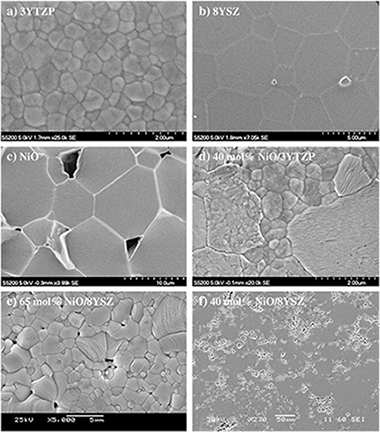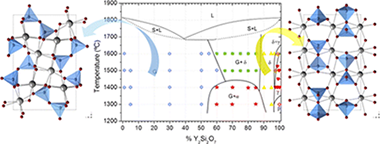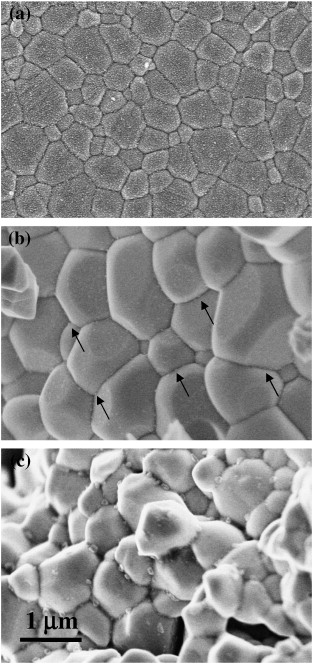Artículos SCI
2012
2012
Materiales de Diseño para la Energía y Medioambiente
Microstructural and high-temperature mechanical characteristics of nickel oxide/zirconia composites for solid oxide fuel cells
Oliva-Ramirez, M.; Huaman-Mamani, F. A.; Jimenez-Melendo, M.Fuel Processing Technology, 103 (2012) 45-50
Show abstract ▽

NiO/8YSZ (8 mol% Y 2O 3-stabilized ZrO 2) composites with different NiO contents (10, 20 and 40 mol%) have been fabricated by a conventional route of mechanical mixing of NiO and 8YSZ powders and sintering at 1500 °C for 10 h in air. The resulting microstructures have been characterized by electron microscopy. In 10 and 20 mol% NiO/8YSZ, the composite is formed by isolated NiO particles surrounded by zirconia matrix grains; this phase is interconnected in the 40 mol% NiO/8YSZ composite. Mechanical tests at constant strain rate and at constant load were conducted on these materials at temperatures of up to 1350 °C. Different behaviors were found depending on the percolation of the NiO phase. Microstructural observations after deformation are essential to understand the overall mechanical behavior of the composites.
Noviembre, 2012 | DOI: 10.1016/j.fuproc.2011.09.013
Materiales de Diseño para la Energía y Medioambiente
Electrical resistivity and thermal conductivity of SiC/Si ecoceramics prepared from sapele wood biocarbon
Parfen'eva, LS; Orlova, TS; Smirnov, BI; Smirnov, IA; Misiorek, H; Mucha, J; Jezowski, A; Pardo, AG; Rico, JRPhysics of the Solid State, 54 (2012) 2132-2141
Show abstract ▽
Samples of β-SiC/Si ecoceramics with a silicon concentration of ∼21 vol % have been prepared using a series of consecutive procedures (carbonization of sapele wood biocarbon, synthesis of high-porosity biocarbon with channel-type pores, infiltration of molten silicon into empty channels of the biocarbon, formation of β-SiC, and retention of residual silicon in channels of β-SiC). The electrical resistivity ρ and thermal conductivity κ of the β-SiC/Si ecoceramic samples have been measured in the temperature range 5–300 K. The values of ρ Si chan(T) and κ Si chan(T) have been determined for silicon Sichan located in β-SiC channels of the synthesized β-SiC/Si ecoceramics. Based on the performed analysis of the obtained results, the concentration of charge carriers (holes) in Sichan has been estimated as p ∼ 1019 cm−3. The factors that can be responsible for such a high value of p have been discussed. The prospects for practical application of β-SiC/Si ecoceramics have been considered.
Octubre, 2012 | DOI: 10.1134/S1063783412100289
Materiales de Diseño para la Energía y Medioambiente
Creep strength of nickel oxide/zirconia composites under different environmental atmospheres
M. Jiménez-Melendo; F.A. Huamán-MamaniSolid State Ionics, 225 (2012) 471-475
Show abstract ▽

NiO/8YSZ (8 mol% Y2O3-stabilized cubic ZrO2) and NiO/3YTZP (3 mol% Y2O3-stabilized tetragonal ZrO2) composites with different NiO contents have been fabricated by a conventional route of mechanical mixing of NiO and zirconia powders and sintering at 1500 °C for 10 h in air. The resulting microstructures have been characterized by electron microscopy. The composites show a duplex microstructure formed by equiaxed grains of NiO and ZrO2, without any intermediate phase. Compressive mechanical tests at constant strain rate were carried out at temperatures between 1150 and 1350 °C under different environments: air, inert (Ar) and reducing (5% H2/95% Ar) atmospheres. The overall creep behavior of the composites is essentially controlled by the zirconia matrix, due to the softness of the NiO phase in the experimental conditions used in this study. The creep strength is not affected by oxygen partial pressure. However, a large decrease in creep resistance under reducing conditions was observed in samples submitted to in situ redox cycling.
Octubre, 2012 | DOI: 10.1016/j.ssi.2012.02.011
Materiales Coloidales
Revealing Structural Detail in the High Temperature La2Si2O7–Y2Si2O7 Phase Diagram by Synchrotron Powder Diffraction and Nuclear Magnetic Resonance Spectroscopy
Fernandez-Carrion, AJ; Allix, M; Florian, P; Suchomel, MR; Becerro, AIJournal of Physical Chemistry C, 116 (2012) 21523-21535
Show abstract ▽

High resolution synchrotron powder XRD, 89Y CPMG NMR, and 139La MAS NMR spectroscopy have been applied to eventually draw the phase diagram of the La2Si2O7–Y2Si2O7 system. The diagram presents a solid solubility region of G-(La,Y)2Si2O7, which extends to the La0.9Y1.1Si2O7 composition at any temperature of this study. Compositions richer in Y show two-phase domains, with G + α at T < 1450 °C and G + δ at T > 1450 °C. The Y-rich extreme is more complex, showing two solid solution regions of δ- and γ-(La,Y)2Si2O7 polymorphs which appear with increasing Y content, respectively. It is interesting to note that the La for Y substitution mechanism in the G-(La,Y)2Si2O7 polymorph is not homogeneous, but a preferential occupation of Y for the RE2 site is observed. Finally, the 89Y and 139La isotropic chemical shift values in G-(La,Y)2Si2O7 have been described here for the first time and assigned to the different RE crystallographic sites of the unit cell.
Octubre, 2012 | DOI: 10.1021/jp305777m
Materiales de Diseño para la Energía y Medioambiente
High-temperature plastic deformation mechanisms of ytterbium-doped barium cerate proton conductor
M. Jiménez-MelendoSolid State Ionics, 225 (2012) 286-290
Show abstract ▽

The enhanced proton conductivity exhibited by trivalent cation-doped barium cerate perovskites makes these materials excellent candidates for electrochemical applications, in particular as electrolytes for solid oxide fuel cells. These devices operate at elevated temperatures, where creep and other deformation processes influence the overall efficiency and lifetime. In this work, the high-temperature plastic deformation mechanisms of fine-grained 5 at.% Yb-doped BaCeO3 polycrystals produced by conventional solid-state reaction has been investigated by means of compressive tests at constant load between 1150 and 1250 °C in air. The creep curves show an unusual sigmoidal behavior, followed by extended steady states of deformation. Grain boundary sliding is the main deformation mechanism, characterized by a stress exponent n of 2, as found in other fine-grained superplastic ceramics and metals.
Octubre, 2012 | DOI: 10.1016/j.ssi.2012.03.031
- ‹ anterior
- 319 of 422
- siguiente ›














